Massive migration from the steppe was a source for Indo-European languages in Europe
- PMID: 25731166
- PMCID: PMC5048219
- DOI: 10.1038/nature14317
Massive migration from the steppe was a source for Indo-European languages in Europe
Abstract
We generated genome-wide data from 69 Europeans who lived between 8,000-3,000 years ago by enriching ancient DNA libraries for a target set of almost 400,000 polymorphisms. Enrichment of these positions decreases the sequencing required for genome-wide ancient DNA analysis by a median of around 250-fold, allowing us to study an order of magnitude more individuals than previous studies and to obtain new insights about the past. We show that the populations of Western and Far Eastern Europe followed opposite trajectories between 8,000-5,000 years ago. At the beginning of the Neolithic period in Europe, ∼8,000-7,000 years ago, closely related groups of early farmers appeared in Germany, Hungary and Spain, different from indigenous hunter-gatherers, whereas Russia was inhabited by a distinctive population of hunter-gatherers with high affinity to a ∼24,000-year-old Siberian. By ∼6,000-5,000 years ago, farmers throughout much of Europe had more hunter-gatherer ancestry than their predecessors, but in Russia, the Yamnaya steppe herders of this time were descended not only from the preceding eastern European hunter-gatherers, but also from a population of Near Eastern ancestry. Western and Eastern Europe came into contact ∼4,500 years ago, as the Late Neolithic Corded Ware people from Germany traced ∼75% of their ancestry to the Yamnaya, documenting a massive migration into the heartland of Europe from its eastern periphery. This steppe ancestry persisted in all sampled central Europeans until at least ∼3,000 years ago, and is ubiquitous in present-day Europeans. These results provide support for a steppe origin of at least some of the Indo-European languages of Europe.
Figures
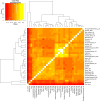
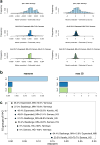

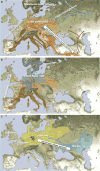

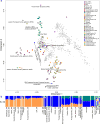
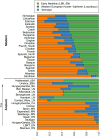
Comment in
-
Human evolution: ancient DNA steps into the language debate.Nature. 2015 Jun 11;522(7555):164-5. doi: 10.1038/522164a. Nature. 2015. PMID: 26062506 No abstract available.
Similar articles
-
Genomic insights into the formation of human populations in East Asia.Nature. 2021 Mar;591(7850):413-419. doi: 10.1038/s41586-021-03336-2. Epub 2021 Feb 22. Nature. 2021. PMID: 33618348 Free PMC article.
-
The genomic history of southeastern Europe.Nature. 2018 Mar 8;555(7695):197-203. doi: 10.1038/nature25778. Epub 2018 Feb 21. Nature. 2018. PMID: 29466330 Free PMC article.
-
Extensive Farming in Estonia Started through a Sex-Biased Migration from the Steppe.Curr Biol. 2017 Jul 24;27(14):2185-2193.e6. doi: 10.1016/j.cub.2017.06.022. Epub 2017 Jul 14. Curr Biol. 2017. PMID: 28712569
-
Heterogeneous Hunter-Gatherer and Steppe-Related Ancestries in Late Neolithic and Bell Beaker Genomes from Present-Day France.Curr Biol. 2021 Mar 8;31(5):1072-1083.e10. doi: 10.1016/j.cub.2020.12.015. Curr Biol. 2021. PMID: 33434506
-
The evolutionary history of human populations in Europe.Curr Opin Genet Dev. 2018 Dec;53:21-27. doi: 10.1016/j.gde.2018.06.007. Epub 2018 Jun 28. Curr Opin Genet Dev. 2018. PMID: 29960127 Review.
Cited by
-
Bioarchaeology aids the cultural understanding of six characters in search of their agency (Tarquinia, ninth-seventh century BC, central Italy).Sci Rep. 2024 May 28;14(1):11895. doi: 10.1038/s41598-024-61052-z. Sci Rep. 2024. PMID: 38806487 Free PMC article.
-
Phylogenetic insights into the genetic legacies of Hungarian-speaking communities in the Carpathian Basin.Sci Rep. 2024 May 20;14(1):11480. doi: 10.1038/s41598-024-61978-4. Sci Rep. 2024. PMID: 38769390 Free PMC article.
-
Pottery spilled the beans: Patterns in the processing and consumption of dietary lipids in Central Germany from the Early Neolithic to the Bronze Age.PLoS One. 2024 May 16;19(5):e0301278. doi: 10.1371/journal.pone.0301278. eCollection 2024. PLoS One. 2024. PMID: 38753872 Free PMC article.
-
Advancing responsible genomic analyses of ancient mollusc shells.PLoS One. 2024 May 6;19(5):e0302646. doi: 10.1371/journal.pone.0302646. eCollection 2024. PLoS One. 2024. PMID: 38709766 Free PMC article.
-
The Genetic Origin of the Indo-Europeans.bioRxiv [Preprint]. 2024 Apr 18:2024.04.17.589597. doi: 10.1101/2024.04.17.589597. bioRxiv. 2024. PMID: 38659893 Free PMC article. Preprint.
References
-
- Keller A, et al. New insights into the Tyrolean Iceman's origin and phenotype as inferred by whole-genome sequencing. Nat Commun. 2012;3:698. - PubMed
Publication types
MeSH terms
Grants and funding
LinkOut - more resources
Full Text Sources
Other Literature Sources
Research Materials
Miscellaneous
